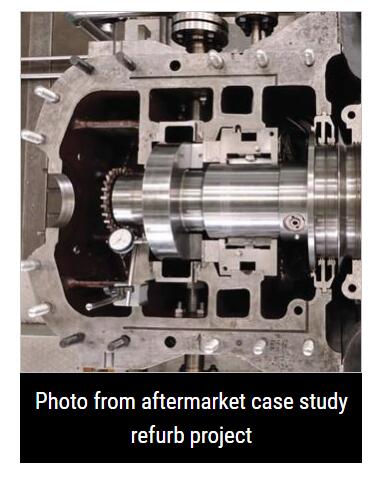Welcome to Sino Bearings web
24x7 HOTLINE:+86-28-81454188

 NEWS
NEWS
Need for energy-efficient systems in the oil & gas sector for greener and environmentally friendly solutions
As the world is moving towards more energy-efficient ways of operation, most licensors and designers of the new refineries, chemical plants and petrochemical plants have become extremely conscious of this fact. As a result, steam balancing and extreme utilisation of steam becomes a key design factor.
In the past few decades, this pushed steam turbine manufacturers to adapt to various level of steam conditions ranging from very low-pressure steam inlets (4 Bar) to supercritical steam (140 Bar) and power ranging from 10kW and up to 30MW or more as per the plant size.
This also put pressure on the existing plants to look at their steam headers closely for available steam and increase the utilisation by pressure reducing stations and removing dump condensers. Using this technique in steam turbines saves on electrical power.
One such example is how Triveni supported a customer with energy saving by offering very high pressure (VHP) to high pressure (HP) solution that led to saving of almost 10MW electrical power and fetching a nominal power cost saving of more than INR 500 million a year in one of the mid-scale refineries overseas.
With this analysis in mind and design capabilities, a steam turbine manufacturer can increase the extent of variable adaptation. By doing so, all sizes of critical equipment like process pump, water pumps, small lube pumps, fans, blowers, air compressor and process compressors etc. can be driven by steam, thus enhancing the energy saving and steam utilisation.
An example here is how Triveni offered a solution to use steam to generate power.
Many chemical plants have cyclic loads by virtue of the processes involved in manufacturing the end product. There are certain exothermic reactions that take place in the course of the chemical manufacturing that can generate steam at lower pressure and temperature which is normally vented out as they are not generated on a continuous basis.
Triveni offered injection – condensing/injection – back pressure steam turbines where the intermittent generation of steam can be injected into the turbine to add more flow to the low pressure (LP) section of the turbine to generate more power at the terminal. Triveni’s steam turbines are equipped with new generation speed – load – extraction control solutions. These are electronic governing systems that can provide a seamless operation to benefit the user.
With rising costs, operating turbines efficiently is a necessity for cost saving and creating a positive carbon footprint. With age, the turbine becomes inefficient and increases the costs of producing power. Triveni’s team works with the customer to understand the current needs and re-design the existing turbine across all brands to meet the new parameters ensuring the turbine is efficient leading to cost savings.
The company’s engineers study the process change requirements of the customer and redesign the existing turbine by modifying the steam flow path to the new parameters. This re-engineering process is carefully done to ensure the existing system i.e., casing, civil foundation, lube oil system etc is retained. The only modification will be the turbine internals (i.e. new rotor, diaphragms and bearings subject to design requirement) to suit the upgraded blade path.
The re-engineering will be done to ensure the old rotor and stator can be reused within the existing casing once the price of power improves, thereby giving the customer flexibility of choosing any option based on the fluctuation of power pricing and enhancing the efficiency in either case scenarios.
Case Study from India
Challenge
A pressure reducing station was used to reduce the low pressure saturated steam from 3.5 barg to 0.5 barg to maintain the header pressure at 3.5 barg. The maximum quantity of steam being reduced was 23 tonnes per hour (TPH). There was a space limitation for turbine installation at the existing site (turbine size is larger due to high volumetric flow rate). And the turbo generator set was located 500m away from the existing main control room.
Solution
The Triveni team visited the facility and recede the space identified for turbine installation. They replaced the pressure reducing dtation with a 500kW back pressure turbine generator set.
The turbine governor is programmed to operate in inlet steam pressure control mode to maintain the header steam pressure. As the inlet steam is a saturated steam, a steam separator has been installed at the inlet steam line to prevent carryover of wet steam into the turbine thereby increasing the life of turbine.
The team offered a turbine with remote start/stop facility along with pneumatic operated valves at inlet, exhaust and drain lines. They optimised the turbine design to meet both the customer budget and space availability.
Benefits
Over 4 million units of “green power” are generated annually. Return on investment (ROI) was achieved in less than 1.5 years of operation
Case Study: aftermarket
A Fortune 500 Petrochemical company had been operating its 17-stage direct drive condensing steam turbine for over 40 years. It envisaged change in its process requirements that could be met by converting the existing “duble extraction condensing” to “single extraction back pressure”.
Triveni Refurb offered a cost-effective solution by modifying the existing steam flow path and replacing only the turbine internals (rotor, diaphragms and bearings).
The existing casing and base frame was retained to ensure no modification in the foundation.
The existing mechanical governing system had to be adjusted at regular intervals to avoid risk to the turbine. This was upgraded to an electronic type governing which was much simpler and reliable.